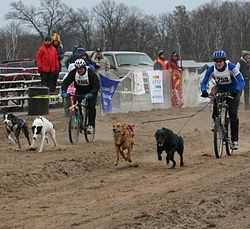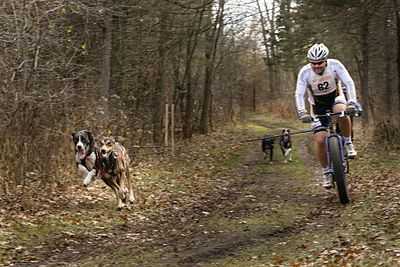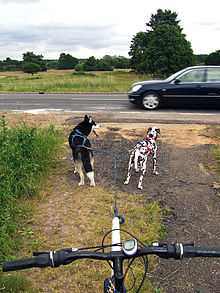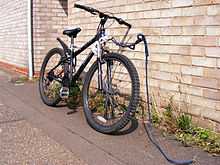Bikejoring

.ogv.jpg)
Bikejoring is a dog mushing activity related to skijoring, canicross, and dog scootering. It is a recreation or sport where a harnessed dog or team of dogs attached to a towline have to pull and run ahead of a cyclist. Bikejoring is a non snow season (dryland) activity. Bikejoring and canicross are both dryland mushing activities that probably developed from skijoring and dogsled racing. Bikejoring is also sometimes used to train racing sled-dogs out of season.
Information
Although any breed (or non-breed) of dog can be used, American Pit Bulls, Siberian Huskies, Samoyeds, Malamutes, Alaskan Huskies, Sled Hounds and Pointers are probably the most popular breeds for bikejoring. However, any type of dog that can be taught to pull, run, and to accept a few lead dog commands can be used to bikejor. Bikejoring and dog scootering are activities that can be beneficial to the health and fitness of dogs. It can be used to provide dogs with work and exercise, without letting them run off leash and endangering wild-life or livestock.
Although often practiced as a dog exercising recreation, in some parts of the World, dog sporting organizations and mushers (people who train dogs to pull - mushing) provide bikejor and dog-scooter racing classes at their competitive dryland sled-dog rallies and events. These competitive bikejor classes often run alongside other classes for canicross and dryland rig racing. In most cases, the competitors are started off separately on a timer, to avoid tangles and collisions.
The dog or dogs are fitted with harnesses suitable for pulling and running in, such as x-back harnesses. The harnesses are normally attached to a gang line (if more than one dog is being used), and a bungee towline, which clips to the front of the bicycle. Many bikejorers use bayonets, antennas, or plastic pipes to suspend the towline above the front wheel, and to prevent it from tangling between the wheel and forks. If two dogs are employed on a gang line, they are sometimes also attached to each other by a neckline between their collars. Bikejoring can be fun but has its dangers. The dogs may be distracted by wild-life.

Bikejoring usually takes place cross country on soft trails. The dogs should not be run far over paved surfaces, as this could damage their paws or limbs. Most bikejor competitions have strict rules over the age and fitness of the dogs, and provide watering spots. The bikejorer also has to take care of their own safety by wearing protective equipment and by keeping the bicycle in good working order. It is important that the towline is not held or attached to the handlebars.
Scooters are often used instead of bicycles, as they are easier to dismount if the dogs decide to give chase to an animal. Although exactly the same as bikejoring except that a scooter is used to carry the musher instead of a bicycle, this activity is known as dog scootering rather than as bikejoring. The musher can still assist the dog/s by kicking at the trail, rather than by pedalling. The scooters used are usually rugged enough for carrying an adult cross country. Some scooters are manufactured specifically for dog-scootering.
An easier and maybe safer alternative to bikejoring or dog-scootering, especially for use in urban and built up areas, is to attach a dog to the side of a bicycle using a number of designed dog-bicycle attachments. However, these patented side attachments are designed to allow a dog to run beside a bicycle, rather than to pull it from ahead. These patented dog-bike attachments usually include some sort of shock absorption, usually a spring. Some of these side attachments can be fitted either side of a bicycle so that two dogs can be exercised at the same time. Examples of these dog-bicycle attachments are the WalkyDog, Springer, bikejor converter and more recently the bikejoring attachment.[citation needed]

External links
| Wikimedia Commons has media related to Bikejoring. |
- ISDRA - International Sled Dog Racing Association
- ESDRA - European Sled Dog Racing Association
- IFSS - International Federation of Sleddog Sports
- German Bikejoering and Dogsccoting site
- UK Group Finder - find you local canicross, bikejor, scootering and dog-carting(rigging) club